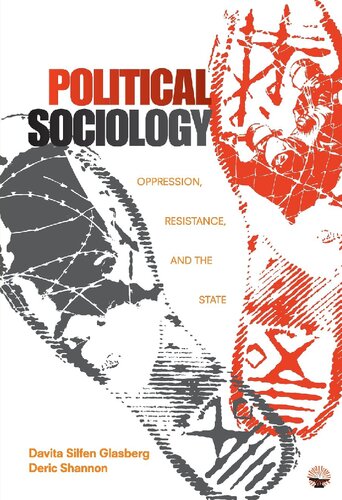

Most ebook files are in PDF format, so you can easily read them using various software such as Foxit Reader or directly on the Google Chrome browser.
Some ebook files are released by publishers in other formats such as .awz, .mobi, .epub, .fb2, etc. You may need to install specific software to read these formats on mobile/PC, such as Calibre.
Please read the tutorial at this link. https://ebooknice.com/page/post?id=faq
We offer FREE conversion to the popular formats you request; however, this may take some time. Therefore, right after payment, please email us, and we will try to provide the service as quickly as possible.
For some exceptional file formats or broken links (if any), please refrain from opening any disputes. Instead, email us first, and we will try to assist within a maximum of 6 hours.
EbookNice Team

Status:
Available0.0
0 reviews
ISBN 10: 1412980402
ISBN 13: 9781412980401
Author: Davita Silfen Glasberg, Deric Shannon
A unique multidimensional view of the relationship between the state, society, and oppression Designed to help students analyze and understand political developments in the world around them, this unique text covers a wide array of political sociology concepts and theoretical perspectives. The book′s multidimensional view emphasizes the interplay between power, inequality, multiple oppressions, and the state. Blending elements of today′s prevalent power structure theories, this framework provides students with a unique focus on the structure of power and inequality in society today. This unique book traces common perspectives within political sociology. However, it adds to the existing field using an intersectional analysis by including state projects around gender, race, and sexuality. Likewise, it engages with commonly ignored perspectives within political sociology such as queer theory, anarchist theory, and post-structuralism. This gives the book a multi-dimensional view that recognizes the need to include, but move beyond, class-based understandings as well as account for the increasing popularity of anarchist, queer, and post-structuralist theories.
Chapter 1. Oppression, Resistance, and the State: An Introduction
Systems of Oppression and the State
Structures of Oppression: Power, Politics, and the State
Political Economy
Patriarchy
Racism
Heteronormativity
Structures of Oppression and Resistance
References
Chapter 2. From the Top Down? Power Structure Theories
Pluralism
Group Pluralism
Elite Pluralism
Critique of Pluralism
Power Elite Theory
Critical Assessment of Power Elite Theory
Class Dialectic Theory
Critical Assessment of Class Dialectic Theory
Poststructuralist Theories of Power
Critical Assessment of Poststructuralist Theories of Power
Comparing Power Structure Theories
The Meaning and Dimensions of Power
Summing Up
Discussion
References
Chapter 3. Is This the Best (or Only) Possible World? Oppression and Socialization
Oppression Values and Ideologies
Individual Rights, Group Interests, and Oppression
Political Socialization
Media
Schools
The State
Patriarchal Socialization and Gendered Oppression
Media
Family
Work
Schools
The State
Resistance to Patriarchal Oppression and Socialization
White Superiority Socialization and Racist Oppression
Media
Family
Schools
The State
Summing Up
Discussion
References
Chapter 4. Power to the People? Voting and Electoral Participation
Who Votes?
Why Don’t People Vote?
Social Psychological Explanations
Structural Explanations
Political Alienation
Why Are People Politically Alienated?
Scandals in Leadership
The Structure of the Political Process
Racism in the Electoral Process
Is There a Gender Gap?
Radical Objections to Voting
Power Beyond Voting
Direct Action
Political Action Committees
Soft Money
Citizens United v. Federal Election Commission
Structural Factors of Power Without Voting
Discussion
References
Chapter 5. Who’s in Charge Here? The State and Society
Marxist Theories of the State
Instrumentalism/Business Dominance Theory: “Capture” or Domination?
Capitalist State Structuralism
Class Dialectic Perspective: “Bringing Class Back In”
State-Centered Structuralism: “Bringing the State Back In”
Anarchist Theory
Theories of the State and Oppression
Discussion
References
Chapter 6. From the Bottom Up? Social Movements and the State
Defining Social Movements
Explaining Social Movements
Absolute and Relative Deprivation Theories
Resource Mobilization
Political Process Perspective
Globalization and Social Movements
Social Movements and State Theory
Discussion
References
Chapter 7. State Policies and Practices: Racialized, Class-Based, and Gendered Oppression
Toward a Multidimensional View of the State, Society, and Oppression
State Projects
Selectivity Filters
Balance of Political and Institutional Forces
Modeling a Multidimensional View of the State, Society, and Oppression
The State and Class-Based Oppression
State Projects of Economic Intervention and Class Oppression
The State and Gendered Oppression
Gendering State Projects
The State and Heteronormative Oppression
The State and Racialized Oppression
Racial Formation State Projects
Intersectionality of Racialized, Class-Based, and Gendered Oppression and State Projects
Summing Up
References
Index
About the Authors
political sociology lecture
sociology politics
sociology and politics books
political sociology books pdf
political sociology book author
political sociology book writer name
Tags: Davita Silfen Glasberg, Deric Shannon, Political, Sociology